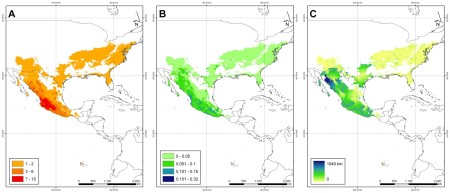- Who needs resistant banana varieties when you have synthetic biology? And more.
- More trouble for wheat, and climate change is to blame. Maybe Vavilov can help there too?
- DIY penicillin.
- Saving the sacred cypress. Try saying that quickly.
- What have herbaria ever done for us? Apart from giving us endless joy, you mean?
- The Indian and other genebanks securing the future of food. But see also our earlier post on Dr Tyagi’s paper.
- Aboriginal community gets a genebank.
- We need better grass. No, not that kind of grass. Well, not only that kind of grass.
- A pean for African food cultures. And Pacific ones too.
Brainfood: Oxygen and seeds, Chicken inbreeding, Non-IPR seed laws, Biodiversity & farm management, Soil agrobiodiversity, Biodiversity & plant protection double, Genebank conservation value, Dichotomies
- Barley seed ageing: genetics behind the dry elevated pressure of oxygen ageing and moist controlled deterioration. There’s seed ageing and seed ageing, genetically speaking.
- Estimates of effective population size and inbreeding in South African indigenous chicken populations: implications for the conservation of unique genetic resources. “Conservation flocks” aren’t working.
- Seed laws, certification and standardization: outlawing informal seed systems in the Global South. The Man uses more than just IPR.
- Farmland biodiversity and agricultural management on 237 farms in 13 European and 2 African regions. The more agriculture, the less biodiversity…
- An Underground Revolution: Biodiversity and Soil Ecological Engineering for Agricultural Sustainability. …but you can do something about it…
- Warming and fertilization alter the dilution effect of host diversity on disease severity. …and this is why you should: plant diversity means better protection against pests and diseases.
- Multi-country evidence that crop diversification promotes ecological intensification of agriculture. No, really.
- Assessing the conservation value of ex situ seed bank collections of endangered wild plants. It’s not just the number of species.
- Biotechnology or organic? Extensive or intensive? Global or local? A critical review of potential pathways to resolve the global food crisis. “…no single pathway will work in every situation.”
Nibbles: Strampelli, Gender, State of World’s Plants, Wild peanuts, Istambul gardens, ICRAF & CIFOR DG chat, Biofortification, Cowpea genome, SSEx Q&A, Rice resilience, Cacao & coffee microbiome, Mapping crops, BBC Discovery, EU seed law
- “È curioso che il grano Cappelli, ora diventato un simbolo della “pasta da gourmet”, fosse una volta il comune grano della pasta di tutti i giorni, e che venga da alcuni considerato “autoctono” quando in realtà è una varietà tunisina.” Curious indeed.
- A woman’s crop? Not as straightforward as it may sound.
- State of the World’s Plants symposium, 11-12 May.
- Above will no doubt consider crop wild relatives such as the peanut’s.
- More on the urban vegetable gardens of Istanbul.
- Tree DGs in the garden getting coffee. On International Forest Day.
- The “Bernie Sanders” vision of biofortification.
- Cowpea to get a genome.
- Q&A with John Torgrimson of Seed Savers Exchange.
- The resilience of rice: “You never find a crop that can span this latitude and altitude.” Really? Wheat?
- Cacao and coffee have a microbial terroir.
- Crop mixes are geographically stable.
- Prof. Kathy Willis of Kew on Feeding the World, including using crop wild relatives. IRRI Kew genebanks featured.
- Denmark interprets EU law to allow seed saving.
The long and winding road to crop wild relative conservation priorities
Those who follow these things will probably have noticed a certain frisson in the press over a paper in Nature Plants on setting conservation priorities for crop wild relatives. Lead authors are Nora Castañeda and Colin Khoury of CIAT, both of whom have featured here before. Good to see Nora celebrating the occasion on Twitter. She really deserves that beer.
Our paper on conservation of CropWildRelatives is published #cwrgap cheers @AgroBioDiverse https://t.co/W7B0VgG0mg pic.twitter.com/OXS25FvrnI
— Nora Castañeda (@np_castaneda) March 21, 2016
Well, I think it’s a beer.
Anyway, I won’t go into the details of the findings here. As I say, it’s all over the news (well, relatively speaking), and you can always explore the results for yourself on the project’s website. But I did want to strike a historical note.
This whole thing started when a small group of us decided it would be kinda fun to apply fancy spatial analysis methods to data from herbaria and genebanks on the distribution of wild Phaseolus species in the Americas. Just to see if it could be done. And whether the results would make any sense.

Well, it could, and they sort of did. And many years, a major international project, two PhDs and a lot of blood, sweat and tears later, we have a global analysis across dozens of genepools and hundreds of species. It was totally worth it, but there should be easier, faster and less expensive ways to get this kind of thing done.
Nibbles: Coffee taxonomy, Agarwood trade, Apios promotion, Dog species concept, Seed collecting, Kudzu control, ICARDA chickpeas, Ancient maize beer, Quinoa landscapes, History of domestication, Breeding mistakes, EU breeding value, Priming, Wild flower ecotypes, Vitellaria use
- Coffee botany resources.
- Uncovering the illegal agarwood trade.
- Developing the potato bean. First step: find a new name.
- Dog taxonomy explained.
- Project Baseline sets a, ahem, baseline, for studying plant diversity under climate change.
- Ok, random shout-out for my niece Francesca’s work on kudzu bug natural control. Because I can. And she’s fabulous.
- Blooming chickpeas!
- The inhabitants of Casas Grandes brewed maize beer in the 14th century. Well of course they did.
- Peruvian quinoa landscapes have a name: aynokas.
- Crop domestication 101.
- Where (commercial) breeders go wrong.
- Presumably none of above mistakes are made by EU plant breeding companies.
- Stimulating plant defences for faster response to pest and disease attack.
- Germany told to go for local meadow seeds.
- Use of shea butter trees goes way back.